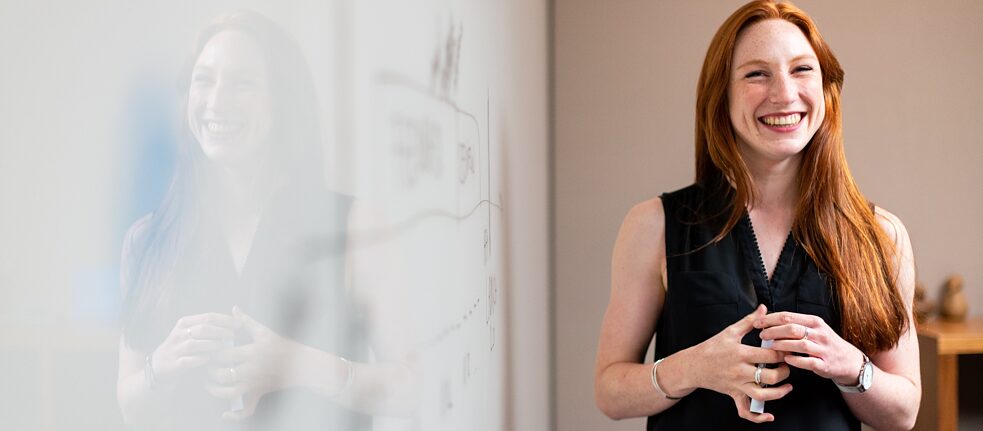Lastingly boosting motivation
Developing teachers’ potential

Teachers face challenges every day at work. Studies show a particularly high level of psychological stress in the teaching profession. Hence the high incidence of burnout among their ranks. So how can we stave off stress while keeping teachers motivated and enthusiastic about their jobs year after year?
By Romy Möller
One answer may lie in what’s known as "New Work", an approach that prioritizes workers’ needs. This concept was developed by Frithjof Bergmann, an Austrian-American philosopher who undertook a critique of work in the 1970s. It seeks to make work more meaningful and fulfilling by allowing for more freedom, autonomy and participation in the community. New Work is much more about attitude than about the tools we use, because what matters is why we do a thing. The idea is to get away from the capitalist ethos of "ever higher, faster, farther" and promote interconnectedness and appreciation instead.
So what does this mean concretely for teachers? How can we make their jobs healthier for body and mind and more fulfilling?
In his 2014 book Reinventing Organizations, Belgian consultant Frédéric Laloux gives some concrete suggestions based on three principles or “pillars”:#1 Self-management: giving teachers responsibility, creative scope and a say in decision-making
The more complex systems become, the less effective top-down leadership becomes. Those at the very top don’t have much insight into the processes and dependencies below. So Laloux suggests decentralizing decision-making, leaving it up to those affected by a given problem since they’re the ones with the requisite expertise to address the problem.What this means concretely for teachers is that they should be given more scope for creativity and decisionmaking to develop and test their own ideas. This is a key to job motivation for people who like taking on challenges and solving problems, who are eager to make a difference and to attain self-fulfilment. It builds their confidence, makes them feel appreciated, and enables and empowers them to get involved and contribute creatively to their work.
This approach can be taken at various levels, e.g. by letting them organize their work or design their projects themselves, or through corresponding participation and co-decision making processes.
Ask yourself:
- How much say do your teachers have in decision making processes?
- How are your participation processes organized and, above all, communicated to your teaching staff?
- How can they propose and, most importantly, implement their own ideas?
- How much responsibility does each teacher have?
#2 Wholeness: showing who you are
The next pillar of Laloux’s model involves showing yourself as a "whole person", with all your strengths… and weaknesses: no need to hide behind a mask anymore, you can simply be who you are.This is a key aspect of everyday working life for teachers – especially in this pandemic era. It’s a shame that we still often see teachers wearing a "professional mask" at school. Many teachers are convinced they have to know everything and do everything right – or at least keep up such appearances at all times. This puts them under a great deal of pressure. Not only that, but teachers are still very much on their own, especially in the classroom. They often feel abandoned, left to cope with problems all by themselves, with no one to turn to. This is where you, as head teacher, come in: you can promote a robust culture of “no blame” and “no shame” support, accepting the fact that everyone makes mistakes.
One means to this end is to hold discussions for teachers to talk openly about the challenges they are up against and provide support for one another, e.g. by forming supervisory groups and sitting in on one another’s classes. The idea is to instil team spirit, to embrace a philosophy of “United we stand, divided we fall”.
#3 “Evolutionary purpose”: less control, greater attunement to the here and now
Laloux calls his third and final pillar “evolutionary purpose”. It’s about how an organization evolves. Laloux exhorts us to “stop trying to predict and control the future, but instead continuously listen and respond to the organization’s purpose”. The point is to adapt as developments unfold, to react to the here and now.Covid-19 has exposed the folly of many a long-term strategy. We should instead become attuned to the present, to what is necessary at any given moment. Hence the importance of the working environment and the prevailing atmosphere and values: How do we work together? What values do we uphold? How does that show in our everyday actions? What is our guiding purpose?
Over the years, a great many studies have confirmed that a sense of purpose is essential to identifying with one’s job. As a head teacher, you can work with your staff to define shared values and develop a corresponding vision. The next step is to work those values and that vision concretely into your everyday practice, into your meetings and communication.
Leadership approach
All three pillars rest on a single foundation: your own approach to leadership. Ask yourself: How do I lead my teaching staff? Any practical approach will prove ineffective if not based on a shared conception of solidarity and human potential, on moving from “No, you do it” to “Let’s do it together” and on communicating and relating at eye level. Is this already the way things work at your school? You can find out by asking your teaching staff (see questionnaire attached). Use their assessments as a springboard for a candid and open-ended discussion, on the basis of which to set changes in motion “together” and explore other avenues.References
Frederic Laloux: Reinventing Organisations: A Guide to Creating Organisations Inspired by the Next Stage of Human Consciousness (Nelson Parker, 2014)
